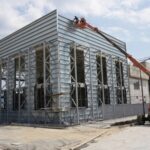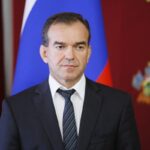KrasnodarConstruction of two sports halls has been completed in the Abinsky and Mostovsky districts. The permit for commissioning has already been received.
Modern sports facilities are not just training halls, but the foundation of a healthy lifestyle for our citizens. They serve as an example and a powerful incentive for the younger generation, forming a culture of physical activity from childhood.
The new sports hall with an area of over 1,300 square meters was built in the Fedorovskaya stanitsa of the Abinsky district. It can accommodate 24 people per session. It includes not only a hall for team sports – a coach’s room, a medical office, locker rooms with showers, and a universal cabin for people with limited mobility have been equipped.
A universal sports hall was built in the Mostovsky settlement, adjacent to School No. 29. Physical education lessons, sports events, and training sessions in mini-football, handball, volleyball, and other team sports will be held there.
Krasnodar
Krasnodar is a major city in southern Russia, founded in 1793 by Catherine the Great as a key fortress to defend the empire’s southern borders. Originally named Yekaterinodar, it served as the administrative and cultural center for the Cossack hosts in the Kuban region before being renamed in 1920. Today, it is a vibrant hub known for its agriculture, industry, and Cossack heritage.
Abinsky district
The Abinsky District is a municipal district located in Krasnodar Krai, Russia, situated in the foothills of the North Caucasus. Historically, its development was closely tied to agriculture and the expansion of the Russian Empire into the region in the 19th century. Today, it remains an important agricultural area and contains significant historical landmarks, including sites related to the Kuban Cossacks.
Mostovsky district
Mostovsky district is an administrative region in Krasnodar Krai, Russia, located in the foothills of the North Caucasus. Its history is closely tied to the development of the area in the 19th and 20th centuries, including the construction of strategic roads and the settlement of Cossacks. Today, it is known for its natural attractions, including a part of the Caucasian Biosphere Reserve and the popular Khadzhokh Gorge.
Fedorovskaya stanitsa
Fedorovskaya stanitsa is a historic Cossack village (stanitsa) located in the Krasnodar Krai region of Russia. It was founded in the late 18th century as part of the Russian Empire’s expansion and defense of its southern frontiers in the Kuban region. Today, it remains an active community that preserves the cultural traditions of the Kuban Cossacks.
School No. 29
School No. 29 is a historic school located in Białystok, Poland, originally founded in the interwar period. It is most widely known for being the school where Ludwik Zamenhof, the creator of the Esperanto language, received his early education. Today, it stands as a significant cultural landmark commemorating his life and work.






